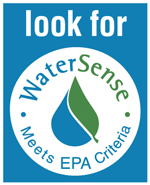Plumbing
The average American uses 100 gallons of water a day at home. The energy used to heat water for bathing and washing accounts for as much as 15-30 percent of household energy use. By installing more water- and energy-efficient plumbing fixtures and equipment, you can achieve long-term utility bill savings. When shopping for fixtures and appliances, look for these labels:


- Keep your water heater set to no higher than 120 degrees Fahrenheit to minimize the scalding risk and save energy in your laundry room, bathroom and kitchen.
- When you adjust the temperature on an electric water heater, be sure to adjust both thermostats. If you don’t do this, one element will work harder than the other and burn out faster. Tanks that are 40 gallons and smaller may only have one thermostat and element.
- Consider installing a tankless (or on-demand) water heater to avoid the standby energy losses of storage tank water heaters.
- Consider hot water solar heating systems after reducing the amount of water you use. While these systems will provide the majority of heated water in the summertime, wintertime gains will be minimal. Look for flat plate technology, as it is more durable and effective than evacuated tube systems. High installation prices give these systems a long payback for the average family.
- If considering a heat pump water heater (HPWH), do your research. HPWH’s take heat from the indoor air so their efficiency is actually dependent on your heating system. These appliances are better installed in hotter climates where air conditioning is common. In our climate, the only situation in which you might consider a HPWH is if you have an unconditioned basement where the surrounding earth insulates and warms the basement.
- If the water heater sits on top of an uninsulated concrete slab, place a piece of rigid board insulation underneath the tank.
- Wrap the hot water tank with an insulation blanket if it is in an unheated space and the tank feels warm to the touch. Do not cover the pressure release valve. On gas-fired water tanks take extra precaution to ensure 6 inches of clearance between the blanket and the flue or burner access. Also adequately secure the blanket with twine; adhesive tape will eventually fail, sag and cover the burner access, which could create a fire hazard.
Equipment maintenance
- Flush the hot water tank as needed (at least once per year) until the water runs clean. Sediment buildup in the bottom of the tank insulates the heat source (either an electric element or gas burner) from the water and reduces efficiency. Sediment and scale build up will depend on your water source.
Plumbing pipes
- When remodeling and planning the plumbing, try to minimize the distance hot water needs to travel from the heater to the bathroom.
- Consider demand-actuated re-circulating pump and control systems. Continuous re-circulating pumps waste far more energy and provide little added benefit over demand systems.
- Install a drainwater heat recovery system to recover heat from warm water. You’ll save money on heating water and possibly increase the capacity of your water heater. These systems are cost effective in homes where an excessive amount of hot water is used.
- Insulate the first six feet of both hot and cold water pipes with a minimum of three inches of insulation. Hot water inside storage tanks rises into both the cold and hot water pipes. When these pipes are uninsulated, the water then cools and falls, creating a convection loop. On both the hot and cold pipes, you can also install check valves, which stops these convection loops.
- Use greywater or rain water to flush toilets rather than potable (drinking) water. This requires dual plumbing distribution lines and a storage tank/filtration system. These types of systems are now more widely available, and meet Seattle and King County plumbing codes when installed correctly.
General fixture considerations
- Be cautious when considering a salvage or vintage faucet, as many are water-wasters and may contain lead.
- Look for lifetime warranties and ceramic disc valves, which are long-wearing and easily replaceable.
Plumbing resources
- Cascade Water Alliance external link
An organization of several King County cities focusing on water conservation efforts. They offer consumer info on ways to save water and take advantage of water saving rebates. - "Find a product" – from WaterSense external link
Helps you find a large variety of home products with the WaterSense label - Saving Water Partnership – for Kitchens external link
Provides several water–saving ideas, with additional information on utility rebates for buying ENERGY STAR appliances
Related information
|


